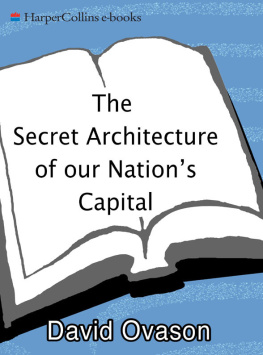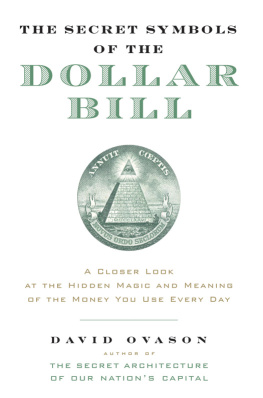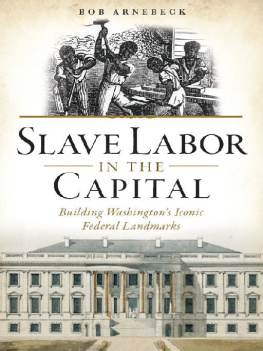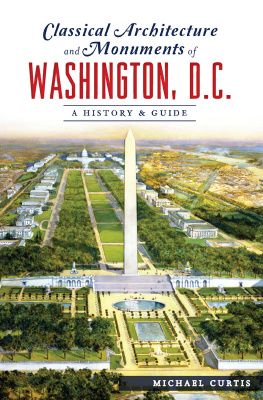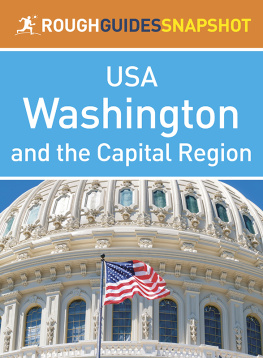The Secret Architecture of Our Nations Capital
The Masons and the Building of Washington, D. C.

David Ovason

Contents
As above, so below. These words, attributed to Hermes Trismegistus, lie at the heart of the Western esoteric tradition. In brief, they mean that the universe and all it contains is reflected in some manner not only on Earth, but also in man and his works. The chief quest of all ages has been mans attempt to understand the mystery of existence and to find his place in it. He keenly observed the movement of the stars, as we read in Genesis 1:14, for signs, and for seasons. Not only have the stars guided the traveler on the earth and seas, but their constellations are archetypes that have been viewed as guides for the lives of men and nations.
In this fascinating and well-researched book, David Ovason presents the remarkable thesis that Washington, D.C., is a city of the stars. He demonstrates that there are over 30 zodiacs in the city, and that the majority of them are oriented in a meaningful way. Even more astonishing is it to learn that these zodiacs were designed to point to the actual heavensthus marrying the Capital City with the stars. This discovery parallels the recent finding in Egypt that the three Great Pyramids correspond to the three stars in Orions belt, while the Nile River occupies the same relative position as the Milky Way. It is still debated whether this was intentional, yet the correlation is undeniable. Similarly, the assignment, position and meaning of Washington, D.C.s zodiacs bespeak a relationship between heaven and earth.
Recent scholarship, such as Steven C. Bullocks Revolutionary Brotherhood: Freemasonry and the Transformation of the American Social Order, 17301840 (University of North Carolina Press, 1996), demonstrates the undeniable influence Freemasonry exerted on the American system of government and lifestyle. Aware of these influences, David Ovason discovered what may be Masonic influences in the architecture and layout of the city. He does not assert that all his correspondences or discovered secrets were laid down by Masons, but there is some support for his argument in documents preserved in the Archives and Library of the Supreme Council, 33, Southern Jurisdiction. As in other Scottish Rite Blue Lodge (Symbolic or Craft) rituals, Albert Pikes Book of the Lodge contains recommendations for decorating the lodge ceiling with constellations and planets. The star map, which is to be painted on the ceiling, is replete with Masonic symbolism that was influenced by French designs in the early 19th century.
The astonishing thing is that Pikes ceiling design reflects precisely the same mysteries observed by David Ovason in this book. These mysteries relate to the constellation Virgo. Pikes map is entirely schematicwhich is to say that it does not reflect the actual positions of the stars in the heavens (Leo could in no way be represented as following Ursa Majoris, for example). Even so, Pike is very clear in allocating his symbolic placing of planets and stars. For example, he places the full Moon between the constellations Scorpio and Virgo. This means that the full Moon is in the constellation Libra, and the star Spica is just above the lunar crescent.
What does this mean to us? The star Spica happens to be the one that David Ovason has shown to be symbolically linked with both Washington, D.C., and the United States as a whole. As the reader will learn, Ovason also suggests that this star may be the origin of the five-pointed star that adorns the American flag. He also suggests that Spica may have been the origin of the Blazing (or Flaming) Star of Freemasonry.
Certainly, it would be far-fetched to draw too many conclusions for a schematic map, but it is evident that Pike visualized his star map as marking the setting of Virgo, along with the constellation Botes, to its north. This is precisely the cosmic setting that David Ovason suggests represents the secret star plan of Washington, D.C. While Pike engineered a schematic time for his star map, Ovason shows that it relates to a number of days centering upon August 10 of each year. The significance of this and other mysteries is fully explored in this work. In view of the meanings that may be traced in Albert Pikes map, we can only wonder if he observed the same correspondences of the city, noted by Ovason, yet for reasons of his own never divulged them.
In any case, David Ovason presents us with a fascinating work that will be sure to captivate and entertain readers interested in architecture, esotericism, Freemasonry, and our nations capital. His thesis may be controversial, but it is well thought out and presented.
C. Fred Kleinknecht, 33, Sovereign Grand Commander, The Supreme Council, 33 (Mother Council of the World), Southern Jurisdiction, U.S.A., Washington, D.C.
Come let me lead thee oer this second Rome
This embryo capital, where Fancy sees
Squares in morasses, obelisks in trees;
Which second-sighted seers, evn now, adorn,
With shrines unbuilt and heroes yet unborn
(Thomas Moore, To Thomas Hume, from the City of Washington,
1804, in The Poetical Works of Thomas Moore, 1853, vol. II, p. 296)
The shrouding mists have gone, and with them the frogs and the mud turtles, yet their presence still lives on in the name. Foggy Bottom is the area where the western reaches of Washington, D.C., used to meet with the Potomac River to the southeast of Rock Creek. In modern times, it includes the once-infamous Watergate Complex, and its evocative name has survived in a Metro station, south of Washington Circle.
If you were to walk or drive from this Metro, down to the Watergate Complex and on to the John F. Kennedy Center for the Performing Arts, even as far as the western edge of Constitution Avenue, you would be unlikely to discover the reason for the name Foggy Bottom. The drainage engineers, the landfill experts and the architects of the late 19th century have done their work well, turning pestilential mudflats into habitable land.
Foggy Bottom was originally called Hamburg by a Dutch gunmaker named Jacob Funk, who had settled the area in the mid-18th century with grandiose plans for its development. Incredibly, when, almost 100 years later, in 1859, a gasworks was built in the area, the few householders of Foggy Bottom were delighted: they imagined that the gas fumes would disinfect the muddy land, and somehow make the fogs kinder on their throats.
Although officially Hamburg, it was called Funkstown by the early residents for a considerable time, yet it was scarcely even a village, and certainly not a town. Only a few wood-frame buildings and even fewer brick houses are recorded at Foggy Bottom, as late as 1800. Surprisingly, a pair of red-brick, two-story houses have survived from this time, to the southwest of George Washington University. These were built originally by John Lenthall (who was in charge of the construction of the U.S. Capitol) on 19th Street. At that time, they must have been near the northern edge of the ancient Foggy Bottom. In the 1970s they were moved, brick by brick, to their present location on 21st Street, and in spite of this enforced reconstruction are sometimes said to be among the oldest surviving dwellings in Washington, D.C.
About 1800, a large glassmaking factoryessentially for the windows of the new city buildingswas constructed on the southern edge of Foggy Bottom from bricks kilned in Holland. This factory was located on the square sold as lot 89 in the sales map of 1792 (I have marked this position in black on the map below) which had been drawn up at the behest of George Washington to attract capital and speculators to the new federal district. For a while, the site proved to be an excellent one for a factory, as it faced directly on the Potomac and offered useful wharfage for unloading glassmaking materials.

